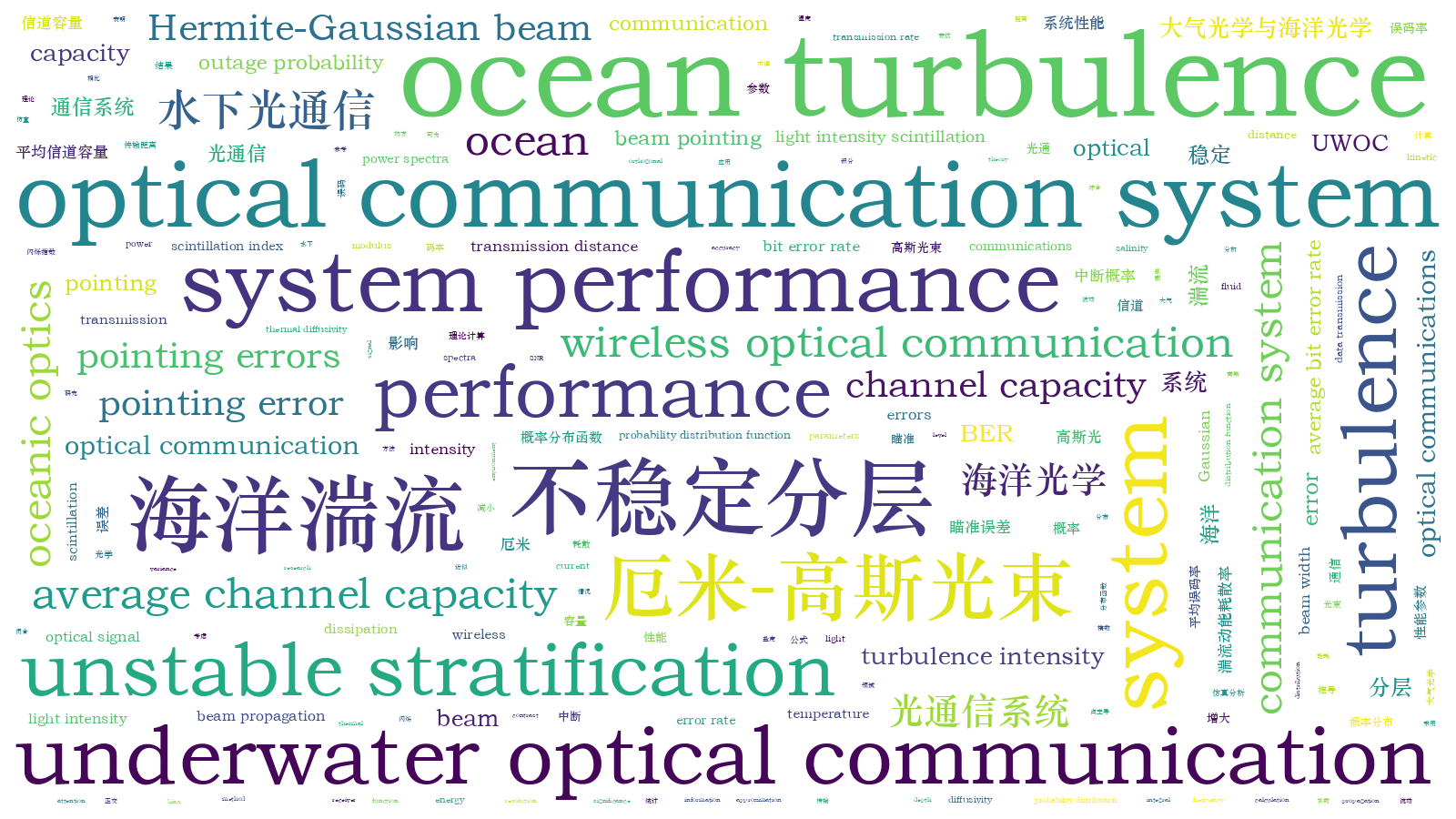不稳定分层海洋湍流对厄米-高斯光通信系统的影响
Underwater wireless optical communication (UWOC) has caught much attention due to its wide frequency band, high information capacity, and fast data transmission rate. However, ocean turbulence causes light intensity scintillation during beam propagation, which increases the difficulty of optical signal resolution in UWOC systems. During establishing underwater optical communication links, Hermite-Gaussian (HG) beams can help to improve system performance by reducing scintillation. Most of the performance studies on current HG UWOC systems employ stable stratification turbulent power spectra, whose computational accuracy cannot match unstable stratification cases. Additionally, current research on UWOC is at the level where the system pointing error must be considered, but this aspect is not addressed in the study of the HG UWOC. According to the literature findings, the study of average bit error rate (BER), average channel capacity, and outage probability of UWOC systems based on unstable stratified ocean turbulence and HG beam pointing error is not reported. Therefore, we investigate the performance of the HG beam wireless optical communication system under unstable stratified ocean turbulence.
We derive the theoretical formulae for the HG optical scintillation index under unstable stratified ocean turbulence and the probability distribution function of the channel coefficients of UWOC systems considering the combined effects of ocean turbulence and pointing error. Meanwhile, theoretical formulae for the main performance parameters of the system are derived, including BER, channel capacity, and outage probability. Additionally, we derive the closed-form expressions for these three performance parameters using the Gaussian-Hermite orthogonal integral approximation method, thus conducting an in-depth analysis of the system performance. To more comprehensively evaluate the system performance in different conditions, we perform simulations to analyze the effects of beam modulus, transmission distance, ocean turbulence, and pointing error on the average BER, average channel capacity, and outage probability of the system under unstable stratification and stable stratification turbulence.
We investigate the performance of HG beam wireless optical communication system under unstable stratified ocean turbulence. The results show that the system BER can be reduced by decreasing the beam width, the HG beam width is reduced from 0.05 m to 0.01 m at an SNR of 30 dB, and the average BER is reduced from 6.18×10-7 to 2.0×10-8. The increase in transmission distance results in the rising system BER. Additionally, we compare the differences in the effects of system performance on unstable stratification and stable stratification turbulence. It is found that the average BER for the stable stratification case in temperature-induced ocean turbulence is much lower than the average BER for the unstable stratification case. Since the eddy thermal diffusivity of seawater should be greater than the salt diffusivity in a temperature-induced ocean environment, the stable stratification assumption underestimates the ocean turbulence intensity. The system performance in the unstable stratification case is better when induced by salinity. Under the stable stratification assumption, the average channel capacity can be close to 0 in certain conditions to prevent reliable communication. In contrast, the average channel capacity in the unstable stratification case is greater than that in the stable stratification case. Meanwhile, the increase in the mean square temperature dissipation rate and the decrease in the turbulent kinetic energy dissipation rate per unit mass of fluid lead to decreased average channel capacity and increased outage probability. This indicates turbulence intensity increase, thus causing deteriorated system performance. Finally, as the variance of the pointing error increases, the light intensity at the receiver end becomes weaker and cannot meet the requirements of the resolved signals, with degraded system performance.
We investigate the performance of a wireless optical communication system using the HG beam under unstable stratified ocean turbulence. Meanwhile, The closed-form expressions for the scintillation index of the HG beams and the average BER, average channel capacity, and outage probability of the optical communication system which take into account the pointing error are derived from the power spectra of the unstable stratified ocean turbulence. The simulations analyze the effects of beam modulus, transmission distance, ocean turbulence, and pointing errors on the system performance. The results show that the unstable stratification theory can correct the bias of ocean turbulence intensity caused by the stable stratification assumption, and then reduce the calculation errors of BER, channel capacity, and outage probability of the UWOC system, and have better system performance in the salinity-induced cases. Additionally, the increasing mean square temperature dissipation rate leads to a decreasing turbulent kinetic energy dissipation rate per unit mass of fluid, rising pointing error, reducing system channel capacity, and increasing outage probability. The results have implications and significance for studying underwater optical communications.
丁桂璇, 杜星, 杜浩, 王生, 敖磊, 李崔春. 不稳定分层海洋湍流对厄米-高斯光通信系统的影响[J]. 光学学报, 2024, 44(6): 0601008. Guixuan Ding, Xing Du, Hao Du, Sheng Wang, Lei Ao, Cuichun Li. Effects of Unstable Stratified Ocean Turbulence on Hermite-Gaussian Optical Communication System[J]. Acta Optica Sinica, 2024, 44(6): 0601008.







